Strawberries
Meeting Series Announcement for the Production Year 2013-2014: Principles of Successful Strawberry Cultivation on the Central Coast of California
This is an announcement for the beginning of a series of meetings to run through the upcoming strawberry season concerning the principles of successful strawberry cultivation on the Central Coast of California. The first of these meetings will be a review of strawberry transplanting and will take place at the ALBA Rural Development Center on 1700 Old Stage Road on October 8. Agenda is here:
http://cesantacruz.ucanr.edu/files/170337.pdf
Further meetings are to follow and should take place more or less every month at various locations around the Central Coast and will concern topics of a timely nature in strawberries. So for example there will be a meeting on lygus bugs in April or May, fertility management in February, irrigation in March, pathogens in March and spider mites in June. If we get a new bug coming our way, why we'll have a meeting about that too. We have the good fortune to count with a first class group of academics and agricultural professionals from UC Cooperative Extension, the University of California and other industry associated organizations and thus have the privilege to extend some of the best information around in a language everybody can understand.
Depending on who is presenting, some of the meetings and presentations will be held in Spanish with translation to English, while others will be in English with translation to Spanish. The emphasis is that these meetings are open and accessible to all of you involved in the industry of producing strawberries on the Central Coast.
So just be aware that over the next ten months this series of meetings will be taking place and to stay apprised of when they are coming about.
I am really looking forward to putting on these meetings with all of you!
Mark
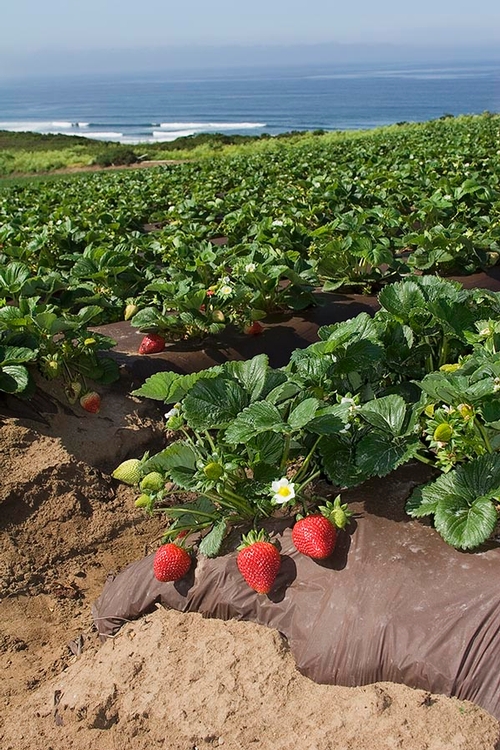
Announcing a series of meetings on the principles of strawberry cultivation to be held over the production season 2013-2014.
Use of glyphosate (Roundup) to control field bindweed in blackberries
Field bindweed, Convolvulus arvensis, also known locally as morning glory, is a persistent weed pest in blackberries grown on the Central Coast of the California. Much of this stems from the long period of time between plant establishment and final removal of the crop some five to six years later.
While cultivation of the aisles between the hedgerows is successful in keeping the field clear of most weeds, field bindweed is another matter. Not only does field bindweed establish very deep root systems which frustrate control by cultivation, but the lengthy vines of this plant grow into the hedgerow and even up onto the plants themselves (Photo 1). Spray applications of translocated herbicides like Roundup are risky due to sensitivity of blackberry to spray drift. For this reason we have selected ropewick application methods to reduce the possibility of spray drift and crop injury.
The study described here is an experiment of two methods of wick applications of glyphosate (Roundup). One method, pictured below, is of a ropewick applicator (Photo 5) which applies a 33% volume per volume (v/v) dilution of formulated product through the ropewick applicator directly to the bindweed leaves by briefly passing over the area in a purposeful back and forth swinging motion. The second method, used occasionally on woody vines which die slowly, was to clip approximately 1”x1” sponges soaked with a 33% v/v dilution of formulated product with colorful refrigerator magnet clips to individual bindweed leaves (Photo 3). In both cases, great care was taken to avoid contact with blackberry plant parts, especially canes hanging down close to the ground. Please note – blackberry is very sensitive to Roundup (Photo 7) and contact with foliage must be absolutely avoided.
As can be seen from the pictures below (Photo, 3, 4 and 5), after two weeks both methods are quite effective in controlling field bindweed in blackberries. It should be noted that the clip method, while quite effective in controlling field bindweed, is far more time consuming than the ropewick applicator and not recommended.
It is lastly important to note that regular retreatment of the field bindweed especially in the fall will be more successful with the ropewick method described here. One should treat regularly but not too frequently and every month to six weeks should work. Let the bindweed regrow some, since it is going into the fall and it is storing starch reserves for its roots. As the bindweed makes sugars in its leaves it is sending that sugar downward into its roots deep in the ground, and this is the time to send some glyphosate into those roots. These roots are the bindweed wheelhouse and this is where to hit it where it hurts.
The use of glyphosate (Roundup) is extensively written about in this article. Before using any of these products, check with your local Agricultural Commissioner's Office and consult product labels for current status of product registration, restrictions, and use information.
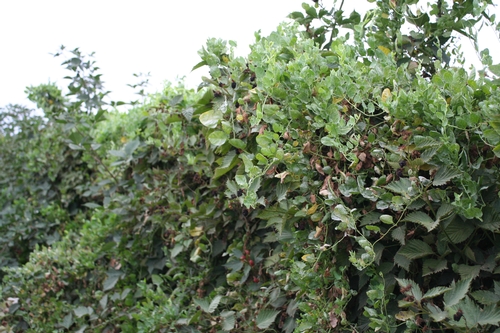
Photo 1: Blackberry hedgerow totally overgrown with field bindweed.
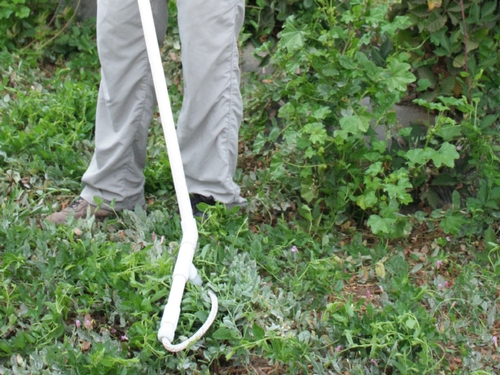
Photo 2: Demonstration of ropewick applicator. Roundup mix, stored in handle, seeps out rope at bottom of applicator.
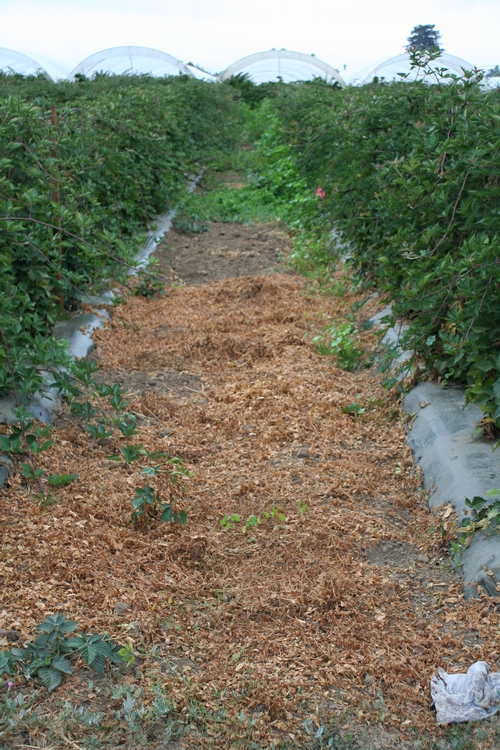
Photo 3: Roundup treated area two weeks post-application.
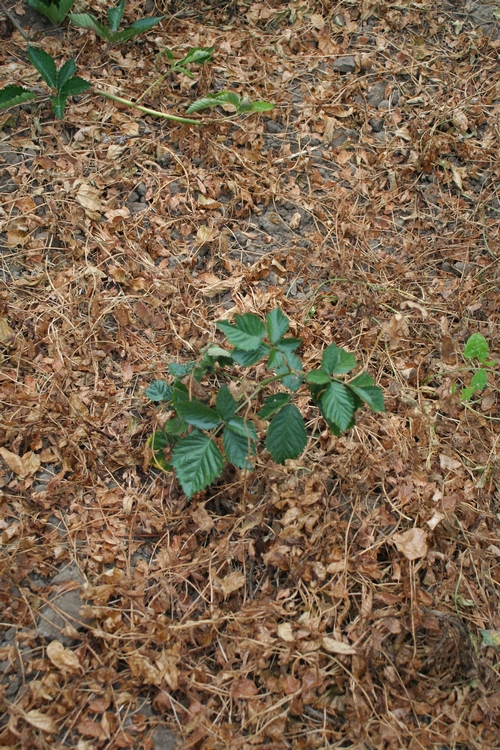
Photo 4: Blackberry primocane in midst of glyphosate killed bindweed. Plant was not touched by the herbicide.
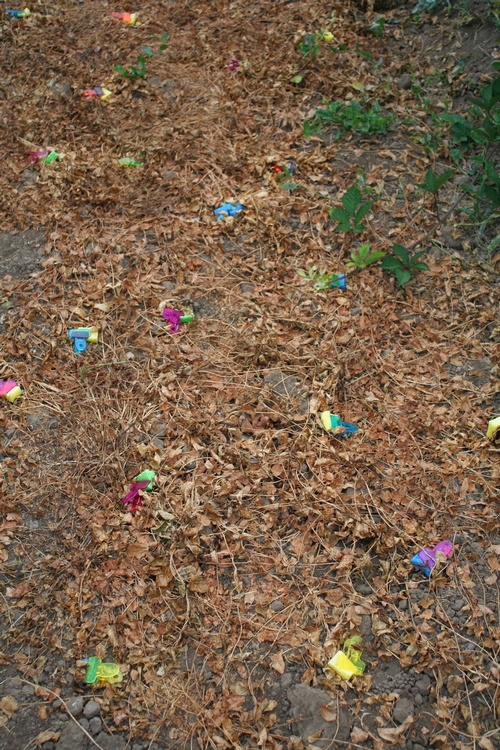
Photo 5: Field bindweed plants two weeks after having been treated with Roundup saturated sponges clipped onto individual leaves.
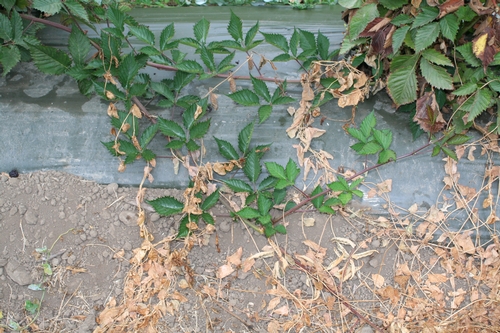
Photo 6: Bindweed vine arising from plants treated by ropewick application interspersed among healthy blackberry canes.
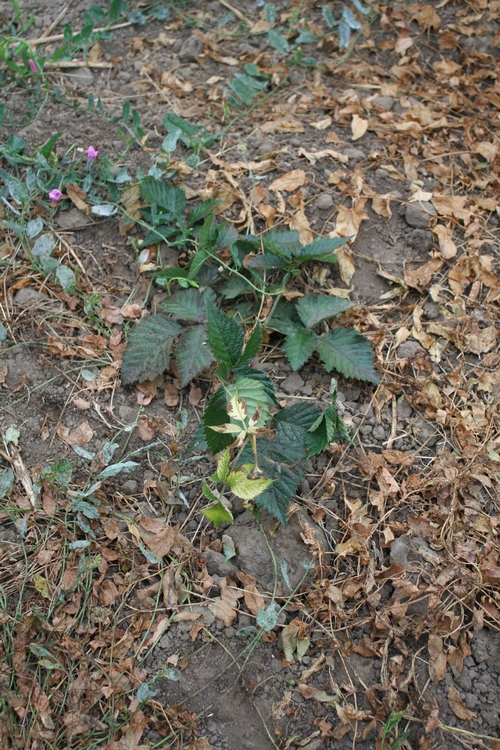
Photo 7: Glyphosate damage on blackberry - very sensitive.
Organic Strawberry Meeting September 18
There will be an organic strawberry meeting sponsored by Lisa Bunin with the Center for Food Safety taking place at the UCCE auditorium 1432 Freedom Blvd in Watsonville this coming Monday, September 18.
Featured will be developments in organic plant stock, anaerobic soil disinfestation, steam disinfestation and development of organic plug plants.
Agenda is featured below. Please let Lisa Bunin <lbunin@centerforfoodsafety.org> know if you are planning on going so as to be able to adequately prepare for the meeting.

Organic Strawberry Summit.pdf
New Primocane Blackberry Variety Prime Ark 'Freedom'
Really nice video clip on the new Prime Ark 'Freedom' variety just released by John Clark from the University of Arkansas breeding program. It's the first commercially available thornless primocane bearing blackberry.
Please take note growers that this variety is very much oriented to the home gardener and not intended for large scale production for shipping.
Very nice explanation too by Dr. Clark on the difference between primocanes and floricanes. Have a look.
Raspberry Crown Borer in Raspberry
While raspberry crown borer, Pennisetia marginata, is not an unusual pest in local blackberries, this is the first time we've found it in raspberry on the Central Coast for a while.
As one can see from the the first photo below, the wilt of the affected raspberry plant is quite sudden. Unlike what we find in blackberry however, the borehole in these raspberries is well below the soil line, more than a half an inch easily. Pointing to a diversity of population, some channels leading into the cane from the borehole were empty, while others had larvae and yet others had soon to eclose pupae nestled within.
There are several approaches to management of raspberry crown borer. The commonly practiced shortened production period of two years or less of raspberries on the Central Coast goes a long way to limiting the establishment and in my mind has made greatly minimized the presence of this pest in its namesake host. In short, removal of infested cane will do a lot in limiting infestations, especially if one is removing canes with late stage raspberry crown borer within.
There are also pesticides labeled for use against raspberry crown borer, and these can be effective, especially over a two year term of treatment in bringing infestations under control. Please note the restrictions and special conditions of these two:
Diazinon is registered for a drench application for raspberry crown borer, but the label restricts this application to “spring, before bud break. Potential users of Diazinon should be aware that there are water quality issues associated with this pesticide.
Admire has a label for caneberries, the only caveat would be the 7 day PHI and caution to not use it when bees are actively foraging. This is a material that is going to be traveling around actively in the plant, but one should bear in mind that applications should be made with plenty of water as the active ingredient in Admire of imidacloprid has a real affinity for soil particles and can get hung up there if there isn’t enough water behind it.
8/29/13 addition: If making the decision to use Admire, please do take note that this material should not be applied during bloom and when bees are foraging.
Thanks to the grower for having me out, I always appreciated getting these calls to come out and have a look at something new and interesting.
The above article discusses the use of several pesticides for management of raspberry crown borer in caneberries. As always, before using any of these products, check with your local Agricultural Commissioner's Office and consult product labels for current status of product registration, restrictions, and use information.
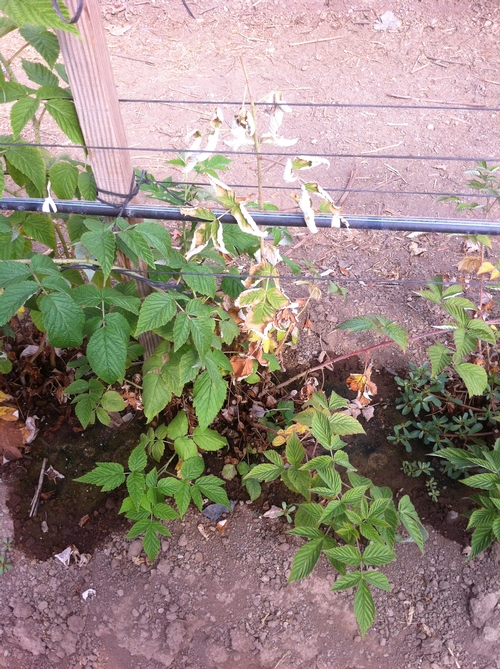
Sudden wilt of raspberry cane typical of raspberry crown borer infestation.
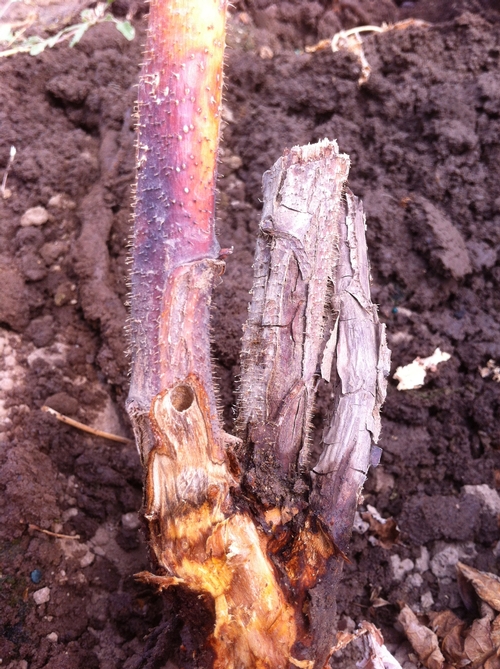
Borehole from raspberry crown borer. Note clean edges of hole - no frass and not typical.
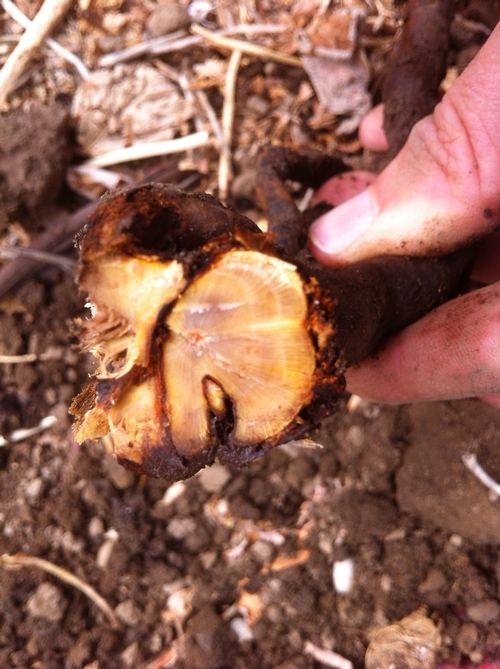
Top view of raspberry crown borer gallery - note discoloration and frass.
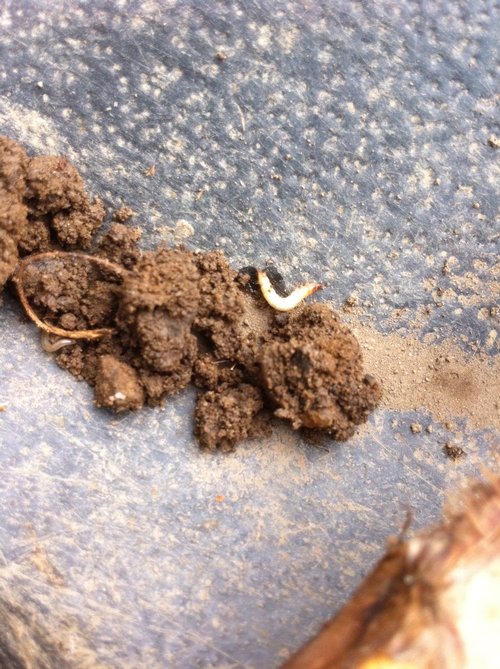
A raspberry crown borer excavated from its burrow in the cane.
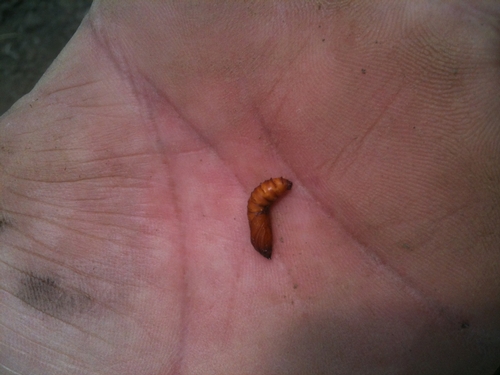
Raspberry crown borer pupa removed from wilted cane. This one will eclose (meaning the adult moth with emerge) quite soon.

